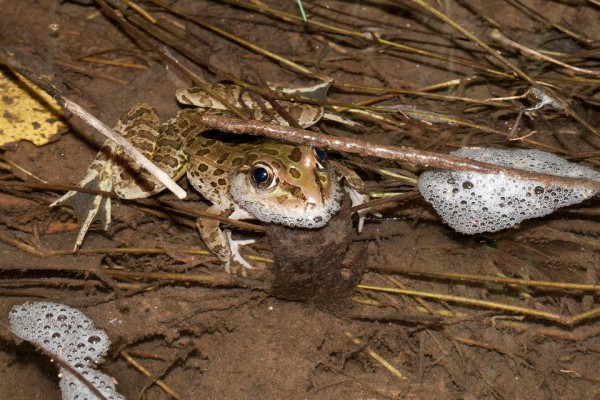
The lowland leopard frog is the focus of SCBI postdoc Anna Savage's work looking at the relationship between genes and chytrid resistance.
Chytridiomycosis, the disease wiping out frog species around the world, was described in 1999 by a team of researchers at the Smithsonian and the University of Maine. Today, in addition to creating an insurance population for various Panamanian species, the Smithsonian Conservation Biology Institute aims to find a way to manage this disease. One of the most promising solutions to stopping the killer may rest in genetics. SCBI scientists are looking to identify genes within frogs that provide resistance to the pathogen or that make them more susceptible to it.
Researchers pursuing this approach are optimistic that genetics could provide different answers than those offered by probiotics, which SCBI is also pursuing. The genetic approach is one based on natural selection.
“If you look across species, including humans, diseases rarely wipe out an entire species without any evidence of resistance, regardless of how virulent they are,” said Anna Savage, an postdoctoral fellow in SCBI’s Center for Conservation and Evolutionary Genetics studying the genetics of chytrid. “Immune systems are so complex that there’s a strong possibility for the development of resistance. The probability that a species develops no resistance to a disease is rather small.”
Genetics research within the last decade has identified frogs with varying degrees of resistance to chytrid. Savage is focusing her research on the lowland leopard frog (Lithobates yavapaiensis), which exhibits an intermediate level of resistance to the pathogen. Some individuals demonstrate resistance while others of the same species die if infected with chytrid. The identification of genetic variations between the individuals holds the potential of being the answer between life and death. One of the new frontiers for genetic research is the examination of a frog species’ immune system genes.
“If we can identify the genes responsible for resistance, we can breed the animals in captivity to ‘spread’ this genetic resistance and give adaptation a headstart,” Savage said. “This area of research holds the potential for creating populations of self-sustaining frogs that confer resistance to the rest of the population through reproduction.”

Savage's research could hold the key to putting a stop to a deadly pathogen killing frogs around the world.
In order to understand a frog’s response to chytrid, the focus must be broadened to understanding how immune system genes interact with one another and which ones are being expressed during resistance. Savage is using this approach to understand chytrid susceptibility in lowland leopard frogs that are being raised at the Smithsonian’s National Zoo. This approach could potentially help scientists identify genes responsible for chytrid resistance. While this type of research shows considerable potential, researchers are only just beginning to scratch the surface.
“Disease outcomes from chytridiomycosis can depend on several factors,” said Brian Gratwicke, SCBI wildlife biologist and Panama Amphibian Rescue and Conservation Project international coordinator. “Some frogs appear to have innate resistance to the disease and produce antimicrobial peptides from glands in their skin. It is possible that some might acquire resistance through exposure, while other frogs have beneficial anti-fungal skin bacteria or a behavioral preference for temperatures that are bad for the fungus. As the fight against chytrid continues, we remain hopeful that the answers are out there and that Dr. Savage’s work will give us some insight into how this system really functions.”
–Will Lazaro, Smithsonian’s National Zoo
(Frog photo by Jared Grummer; photo of Anna Savage by Dennis Caldwell)
